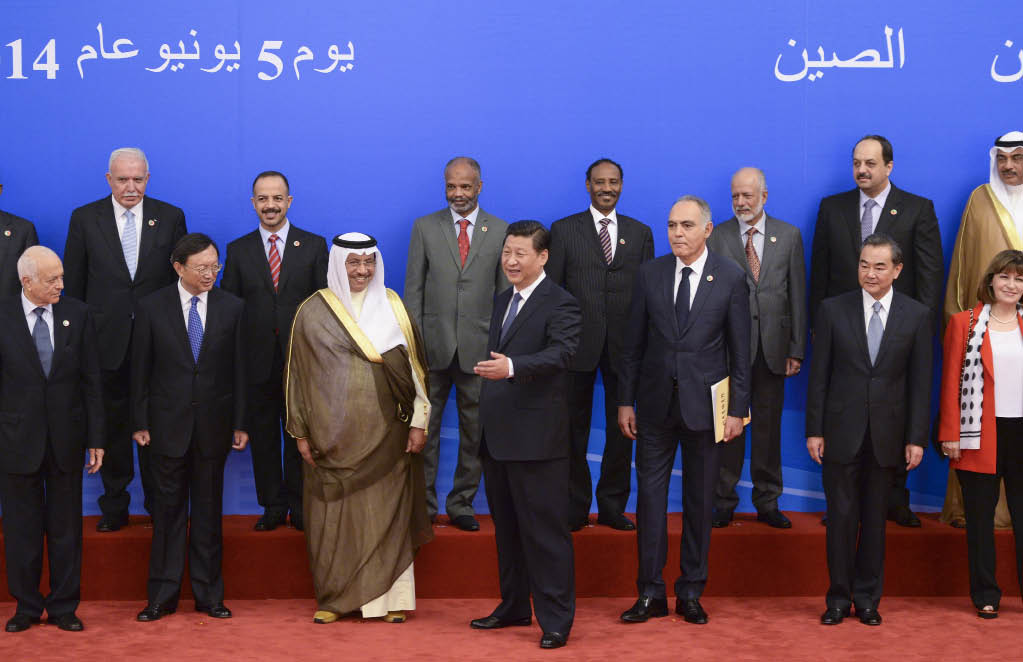Constructing the “One Belt and One Road” Tangram

President Xi Jinping with foreign dignitaries on June 5, 2014, during the sixth ministerial meeting of the China-Arab States Cooperation Forum.
By ZHANG XUDONG
THE earth had no roads to begin with, but when many men pass one way, a road is made." This quote from Lu Xun, a leading figure of modern Chinese literature, describes the legendary history of the ancient Silk Road from one angle. For the Chinese, historical figures such as Zhang Qian and Ban Chao who served as envoys to the Western Regions are household names. But the Chinese are also very familiar with an envoy from the West, Marco Polo, who set out on his trip to China in 1271, and after three years of traveling met and received a warm welcome from Kublai Khan, founder of the Yuan Dynasty (1271-1368). The route that Marco Polo took was the Silk Road, yet it was not known as such back then. In the shadow of this famous Italian envoy is a lesser-known figure, the German geographer Ferdinand von Richthofen, who conducted two expeditions to China in the 1860s and compiled the masterpiece China: The Results of My Travels and the Studies Based Thereon. It was von Richthofen who coined the term "Silk Road."
Generations of explorers of the Silk Road have braved challenges and risks to form the rich history of exchanges between China and Europe. Today, China's strategic initiatives to build the Silk Road Economic Belt and the 21st-Century Maritime Silk Road have witnessed bounding development. As China's Foreign Minister Wang Yi said, the Belt and Road Initiatives, serving as an overarching architecture for China's external cooperation endeavor in the new era, are bound to breathe new life and vigor into the ancient land of Eurasia and give this vast continent two strong wings for its flight toward prosperity.
China is leading the way in the historic mission to construct one belt and one road. Chinese leaders are playing multiple roles as planners, publicists and supervisors, actively and steadily promoting the initiatives. For more than one year since the scheme was proposed, over 50 countries along the routes have responded and participated in its construction, showing the proposal's huge influence and appeal. As a world focus, the "One Belt and One Road" tangram is formed of the following seven pieces.
I. Common Development and Shared Prosperity
For a long time the international community has questioned how a rising China participates in the international community and builds the international order. As for proposals made by China, the world cares more about the value and conception of China they represent. So with the Belt and Road Initiatives, various countries hope that China will make clear its wider purpose and strategic thinking.
On this point, Foreign Minister Wang Yi responded when he attended the 2014 Seminar on International Situation and Chinese Diplomacy. He said that the Belt and Road initiatives, in the spirit of mutual learning and harmonious coexistence reminiscent of the ancient Silk Road, are designed to boost common development and shared prosperity in all countries along the routes, as they uphold the vision for a community of shared destiny. His elaboration explicitly answers the questions from the international community and is consistent with the diplomatic concept and policy of China's new leadership. Further, it embodies China's effort to actively participate in the building of international order. The Belt and Road will connect scores of countries in the Eurasian Continent and will enable billions of people to learn from each other under the new wave of globalization, cooperate with each other and seek opportunities for common prosperity and development. Just like the saying goes, "a single flower does not make spring, while one hundred flowers in full blossom bring spring to the garden." The rise and development of China is a positive factor for the world. China does not indulge in self-admiration, but hopes the international community can benefit from its fast development and achieve common progress. In that process, China is happy at the prospect of forming a community of shared destiny through connectivity and cooperation.
II. Discussion, Co-construction and Sharing
When the Belt and Road Initiatives were proposed, some commentators held that it was a one-sided wish by China and feared that other countries would not support it. Others were worried that the initiatives would follow the old pattern adopted by developed countries whereby only the big nations would have a say in decision making when establishing relevant international organizations or schemes. It is normal for a newly emerged concept to generate doubts. However, the Belt and Road initiatives are self-explanatory.
If we closely observe China's decision-making methods when participating in regional activities and its interaction with international organizations, we can see that China actually pays great attention to the principle of consensus decision making. That is to say, on the multilateral level, a range of voices, from both big and small countries, are heard. China didn't rashly put forward the Belt and Road initiatives alone; it formally made the proposal after negotiating with relevant countries, most notably after synthesizing the ideas of Kazakhstan. Moreover, all parties have discussed how they could best reap the most rewards in the process of their participation. The consent of all parties must be sought in implementing key projects. Relevant countries jointly provide money for the construction, and share the results. A method such as this that emphasizes equality and mutual benefit not only reflects China's core principle of diplomacy, but also forms the foundation for the construction of the Belt and Road initiatives.
